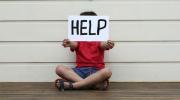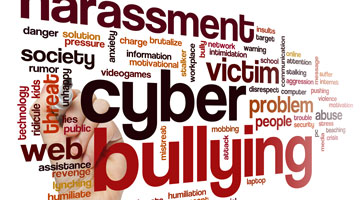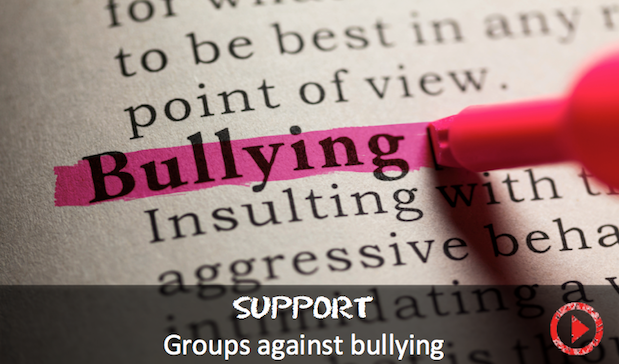language. Otherwise, you're giving them free access to a world that's dangerous potentially and you're never gonna know how to find it or what to do about it. That's the scariest thing. Get up to speed, that's number one.”
So, with the help of expert information compiled on kidsinthehouse.com, let’s get up to speed.
What is cyberbullying
6 out of 10 kids who bully on the playground also participate in cyberbullying but not every cyberbully is participating in playground bullying. However, whether a child is bullying behind a screen or on the schoolyard, their motivations remain the same. “It’s still about social power, at times. It is also about getting attention,” says Joel Haber.
“Cyberbullying is repetitive and it’s malicious,” says Lori Getz, Technology and Internet Safety Expert, “It is sending mean, hurtful, electronic messages. It’s pretending you are somebody that you are not. It’s uploading pictures or video in order to embarrass or harass somebody online.”
The internet landscape and forms of technology are rapidly changing and cyberbullying is adapting with it. Cyber bullies may utilize text, mobile apps, e-mail, or social media to taunt their victims.
Primary Forms of Cyberbullying
Harassment:
Repeatedly sending malicious messages electronically
Flaming:
Closely related to harassment but refers to an online fight taken place in emails, texting, or instant messaging. These fights are often made public by the bully to humiliate the victim. The bully’s message usually uses direct harsh language or images.
Exclusion:
The act of intentionally singling out a person from online groups on social media or chat sites. The group may participate in bullying the victim together by leaving malicious comments in the private group about the one they have singled out.
Outing:
When a bully shares personal, private information about their victim publicly. These can be pictures, videos, or a “secret” shared in public physical spaces(such as their school) or online via social media or an email blast.
Masquerading:
The bully creates a fake identity to harass someone anonymously or to impersonate someone else to send malicious messages to the victims. IN some situations, the bully masquerades as the victim to send messages to other people.
Cyber bullying and Cell Phones
Cyberbullying has been around since the dawn of the Internet, before cell phones were readily in the hands of preteens and teenagers. With the addition of mobile apps and social media, cell phones have become a hotbed for bullying.
“Here is the problem with cell phones: Kids can send out blasts of text messages or email messages and getting kids to feel awful by getting their friends to rally around them. The bigger problem is the videos or the pictures that kids take to embarrass or humiliate. Now all phones have the ability to take videos and pictures,” explains Joel Haber, “So kids go in to restrooms and film things that might humiliate or embarrass them. That's really scary stuff. Remember that, because they have a cell phone, it's the same thing for parents to think about. That is a privilege, not a right. You want to make sure that your kids are not doing those kinds of things. There has to be limits that are given to kids when they are first given that technology and make sure that they abide by them.”
Bully, Victim, Bystander, or Advocate?
As parents of this tech-centered generation, it is important to raise responsible digital citizens who are aware of their actions online and in their social networking sphere.
“Cyberbullying is really an important topic to be talking to your children about. They need to understand what a cyberbullying situation is all about.” says Technology and Safety expert Lori Getz, “You want to make sure your child has a mental map and knows exactly what to do in the case of a cyberbullying incident. What role with they play? Are they the bully, the victim, the bystander, or the advocate? Do they know how to stand up for the victim and make sure that the victim has somebody to turn to?”
Bullies. “Put-downers” who harass and demean others, especially those they think are different or inferior, or “get-backers,” who have been bullied by others and are using the Internet to retaliate or vent their anger.
Targets. The targets of the cyberbully, who in some cases may be the bullies at school, and in other cases the targets.
Harmful Bystanders. Those who encourage and support the bully or watch the bullying from the sidelines, but do nothing to intervene or help the target.
Helpful Bystanders. Those who seek to stop the bullying, protest against it, provide support to the target, or tell an adult. One of the most important strategies to address cyberbullying will be stimulating more students to become helpful bystanders.
What to do if your child is being bullied
If your child is being cyber bullied, they may not come to you for help out of embarrassment, fear you’ll overact, or that you will restrict their online activities to protect them. It is important to speak to your child about bullying and cyberbullying even if you don’t suspect they are being victimized, so that they know how to respond if they are.
“If a child is being cyber bullied, we need to teach them to stop, block, and report,” explains Lori Getz, “Stop, teach children not to engage with a bully online. Make sure they don't try and defend themselves or retaliate. Then you want to teach them to block. Shut down the application or block the user from being able to send any more mean messages. They don't need to read the vicious gossip that is being put out there about them. Then they need to report. They need to tell an adult. This is where things sometimes falter because children believe that if they tell an adult, they will make things worse. If we, as parents, can take a step back and think about how my child feels as a victim and not about getting the bully first, we can take the appropriate actions to make sure that the cyber bullying never happens again.”
Joel Haber agrees with Getz, “You want to make sure you don't react. Print off or save whatever those messages are so that you can give them to an adult later, that's part of what technology means, part of what comes to them, is to show you. You let them know, never to respond because if you respond, you are keeping it going. If they respond, and they are going to want to because their emotions will kick in, but responding will only make the situation worse. As a parent, then have that information and send it to the website provider or the mobile provider, send to a school; so they know it's happening and they can respond and take the steps they need to.”
Effects of Cyberbullying
The effects of cyberbullying cast a wide range including causing stress, anxiety, depression, potential of substance abuse, risk of violence against others, self-harm, or suicide. Like all other forms of bullying, the victims response to cyberbullying is unique but the implications are always serious. A child who is a victim of cyberbullying may have changes in their sleep and eating patterns, express a loss of interest in activities they used to enjoy, skip school or have a drop in grade performance, or have more health complaints. Bullying may lead to thoughts about suicide and these thoughts may continue into adulthood. In one study, adults who had experience bullying in their youth were three times more likely to have suicidal inclinations in their adult years. Bullying may also cause a child to act out in violence against others. In 12 out of 15 school shooting cases in the 1990s, the shooter had a deep history of being bullied by their peers.
Cyberbullying has had an intense impact on America’s schools. According to a study conducted in 2011 by the Center for Disease Control, more than 15,000 students did not go to school because they felt unsafe and at least 20% reported being bullied on school grounds. Over 16% were victims of a form of cyberbullying. Cyberbullying causes a student to retreat from their school communities by dropping out of extracurricular activities, refraining from speaking up or asking questions in class, or a decrease in grade performance.
Cyberbulling’s impact on a family can be long-lasting during and after the abuse. A child may struggle with feelings of failure or feel alone and isolated. The child might develop an obsession over the situation. Parents themselves may share this feeling of obsession--unable to stop thinking about the situation and becoming excessively fearful for their child’s safety. This may lead to an overprotective parenting style that could inhibit the child’s growth or increase anxiety in the home. Children may become angry, agitated, or anxious after experiencing bullying and may need help learning how to deal with their emotions in a healthy and constructive way.
Cyberbullying Prevention
Cyberbullying often goes unnoticed by parents or guardians unless the child brings it to their attention. This is due to fact that cyberbullying takes place in a non-physical realm. Instead of your child coming home with a black eye, they are coming home with abusive texts lurking on their phone. How can a parent protect their child from cyberbullies? Many parents turn to monitoring their child’s digital lives.
“Parents should monitor their kids computer use and cell phone use for a number of different reasons,” says Dorothy Espelage, Professor of Child Development at University of Illinois, “One, kids are in and are considered digital natives. This is where they are living. This is where they are interacting with their friends. This is also where they can get themselves in trouble. I think that parents need to recognize that their monitoring doesn't go away when the kids go up to their bedrooms onto their computer. We need to seriously think about the question: Would you drop your child off at an unlit park for two hours a night? Most parents would say, "Absolutely not." But they will allow their child free access to the computer and cell phone throughout the night. We know that parental monitoring is the number one predictor and protector of kids not getting involved in alcohol and drug use, teenage pregnancy, deviant behavior. Parental monitoring must transfer into the social media interactions that kids have everyday.”
Some studies have shown that an effective means of stopping bullying is giving kids the ability to report bullying anonymously. When victims and bystanders are able to report anonymously, they feel freedom from the fear of retribution from the bullies or punishment from parents or school administrators. Cyberbully Hotline is an anonymous bully reporting and school tip hotline that you may want to share as a resource with your kid.
Our Experts
For more advice on preventing cyberbullying, turn to our top experts at kidsinthehouse.com







































